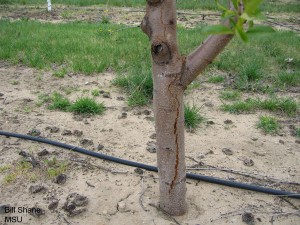Date: Thursday, February 13, 2014
Time: 8:00 am – 2:00 pm
Location: Rutgers Agricultural Research & Extension Center
121 Northville Road, Bridgeton, NJ [Read more…]
Tree Fruit Edition
Seasonal updates on insects, diseases, weeds, maturity dates and cultural practices impacting only tree fruit.
Subscriptions are available via EMAIL and RSS.
South Jersey Commercial Tree Fruit Grower Meeting
2014 Tree Fruit Meetings for Commercial Growers
A full slate of tree fruit meetings sponsored by the New Jersey Agricultural Experiment Station and Rutgers Cooperative Extension have been scheduled for the upcoming 2014 growing season.
The season begins with:
- South Jersey Tree Fruit Meeting –
February 13@ RAREC Note: New Date Feb 14 - North Jersey Fruit Meeting – March 7 @ Warren Grange
These annual “winter” meetings are followed by a series of evening fruit meetings in both northern and southern NJ throughout April, May, and early June. Some of these latter evening meetings will be at grower sites. The meeting season culminates with the RAREC Fruit Research Field Day on June 26, which will include visits to research vineyards as well as orchards.
[Read more…]
How Cold Did it Get?
Integrate Sanitation Into Your Apple Scab Control Program

Apple Scab Control with Urea.
Video link: http://youtu.be/8g0WyVi68GM
This past season we saw elevated levels of apple scab in southern counties. Our IPM scouts found low levels of scab present in orchards where scab had not been detected for many years, even though these orchards had been carefully sprayed using effective materials. Most likely what we are witnessing is the result of an increasing pattern of wet seasons with periods of extreme rainfall and not resistance to DMI fungicides, although that is an area of great concern and cannot be ruled out. Regardless of the cause, high inoculum in the orchard will eventually lead to control failures with materials such as the DMI’s and other chemistries prone to resistance.
At any rate growers that had scab this year should integrate sanitation practices into their scab control program. The recommended sanitation program involves either: fall or spring applications of Urea; flail mowing fallen leaves: or preferably both.
Dr. Dan Cooley and Jon Clements at UMass have uploaded a short video explaining this approach.
Fruit IPM Report: Week Ending 9/13/13
Fruit IPM Report 9-13-13 – Click to View | Download | Print
In this report:
- Blueberry
- Apple
Brown Marmorated Stink Bug:
Most of the BMSB that are being captured are adults. Since many crops have already been harvested, apples, particularly late season apples are being exposed to the full onslaught of adult BMSB movement. Be particularly aware of fruit bordering soybeans and woodlands. Late season injury can come on fast, and some injury is not apparent until several weeks after picking.
Keep fresh insecticide applied to the trees, particularly on border rows and end trees. Effective insecticides along with the (PHI) include: Baythroid (7), Belay (7), Danitol (14), Leverage (7), Mustang (14), Brigade/Bifenture (14) (section 18), and Scorpion/Venom (3) (section 18). Those listed in bold are some of the best materials.
Click to view, download, and print copies of the newest Scorpion and Venom labels.
Fruit IPM Report: Week Ending 8/31/13
Fruit IPM Report 8-31-13 – Click to View | Download | Print
In this report:
- Peach
- Apple
- Pear
- Grape
- Scouting Calendar
- Blueberry
- Trap Counts

